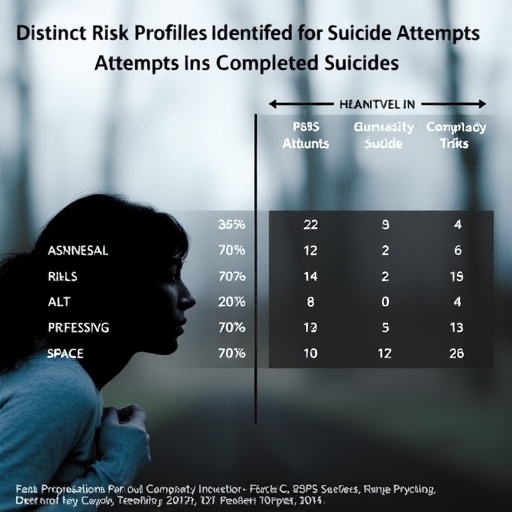In a groundbreaking new case-control study presented at the 2025 World Congress of Psychiatric Genetics, researchers have uncovered critical distinctions in the risk factors associated with suicide attempts and completed suicides. This innovative research challenges long-held assumptions in psychiatric risk assessment, revealing that these two profoundly tragic outcomes do not fully overlap in their underlying determinants. The implications of these findings are vast, potentially altering frameworks for suicide prevention, risk prediction modeling, and clinical screening protocols.
Suicide remains a leading cause of death worldwide, representing a major public health challenge. Conventional suicide-risk assessment tools traditionally do not differentiate between the risk factors for suicide attempts and those that precipitate suicide completion. This study, however, employed rigorous case-control methodologies to parse out subtle yet significant differences in the profiles of individuals prone to attempting suicide versus those who ultimately die by suicide. Such distinctions may open new avenues for tailored interventions and preventative strategies that are more precise and effective.
The research team, led by Fenfen Ge, MD, PhD, from Aarhus University, utilized extensive clinical and epidemiological data sets to examine various psychological, behavioral, and biological contributors to suicide risk. By comparing cases of suicide attempts with completed suicides and matched control groups, the investigators identified distinct patterns of vulnerability. These patterns illuminate how certain risk factors may predispose individuals to suicidal ideation and attempts, while a different constellation of factors might influence the transition to completed suicide.
One of the most compelling findings is that the overlap between suicide attempt risk factors and those predicting suicide death is incomplete, underscoring the complexity of suicidal behavior. For example, factors such as impulsivity and acute stress responses were more strongly correlated with attempts, whereas chronic psychiatric conditions and severe neurobiological dysregulation showed stronger ties to completed suicides. This suggests that a one-size-fits-all approach to suicide risk assessment could miss critical warning signs depending on the suicidal trajectory.
From a neurobiological standpoint, the study highlights distinct mechanisms operating in the brain’s stress response and reward processing systems. Dysregulation in these systems may differentially modulate risk propensities toward attempts versus completion, reflecting nuanced neural circuit dysfunctions. Such mechanistic insights are vital for developing pharmacological and behavioral therapies that target precise pathways involved in suicidal behavior.
In addition to biological factors, psychosocial elements were rigorously evaluated. The investigation revealed that social isolation, access to lethal means, and past trauma played variable roles in mediating risk for suicide attempt compared with suicide completion. The role of protective factors such as social support networks was also dissected, indicating differential buffering effects depending on the suicidal outcome examined, thereby informing community and clinical interventions.
Clinically, these findings pave the way for refined screening tools that can better stratify patients according to their unique risk profiles. The ability to distinguish whether a patient is more likely to attempt suicide or progress toward completion could guide personalized care plans, including the intensity and type of monitoring, therapeutic approaches, and follow-up schedules. It also underscores the importance of ongoing risk reassessment in diverse clinical contexts.
Moreover, the study emphasizes the imperative to integrate genetic and epigenetic data into risk prediction models. By identifying genetic susceptibilities that differentially influence suicide attempt and completion risk, the research invites a new era of precision psychiatry where genomic information will complement clinical and psychosocial assessments to optimize prevention strategies.
The author team calls for future research to validate these findings across broader demographic groups and geographical regions, including longitudinal studies that can elucidate the temporal dynamics of risk evolution. Furthermore, they advocate for interdisciplinary approaches that combine psychiatry, genetics, neurobiology, and social sciences, fostering comprehensive frameworks to address the multifactorial nature of suicide.
This research not only advances scientific understanding but also carries significant ethical and policy implications. It urges stakeholders in health care systems, mental health services, and public health policy to rethink suicide prevention protocols, resource allocation, and training programs for clinicians. Enhanced awareness about the heterogeneity of suicide risk could reduce stigma by framing suicidality as a complex, multifaceted phenomenon require nuanced interventions.
In summary, this pivotal study disrupts traditional paradigms by demonstrating that suicide attempts and completed suicides are governed by overlapping yet distinct risk factors. The results compel a paradigm shift toward differentiated risk prediction and personalized preventive measures. As global suicide rates reflect the urgent need for improved intervention, these findings offer promising scientific pathways to save lives.
Fenfen Ge, MD, PhD, the study’s corresponding author, encourages colleagues and media representatives to delve deeper into the full publication accessible via JAMA Psychiatry for an exhaustive exposition of the methodologies, analyses, and clinical implications. Harnessing these insights to develop next-generation suicide prevention strategies is an urgent imperative for modern psychiatry.
Subject of Research: Suicide risk factors differentiating suicide attempt and suicide completion
Article Title: [Not Provided]
News Publication Date: [Not Provided]
Web References: [Not Provided]
References: (10.1001/jamapsychiatry.2025.3444)
Image Credits: [Not Provided]
Keywords: Suicide, Risk factors, Controlled trials, Patient monitoring, Psychiatry




